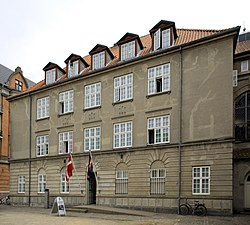Occupation Museum, Aarhus
Besættelsesmuseet | |
 The facade of the Occupation Museum | |
 | |
| Established | 2001 |
|---|---|
| Location | Mathilde Fibigers Have 2, Århus Denmark |
| Type | History museum |
| Website | Occupation Museum |
The Occupation Museum (Danish: Besættelsesmuseet) in Aarhus, Denmark is a history museum dedicated to present the history of Aarhus during the German occupation in the Second World War. The museum is situated in the historical centre, the Latin Quarter, in Midtbyen and shares the building of the Women's Museum. The building is a listed structure and it is the former city hall and police station of the city, constructed in 1856-57. In the later part of the war it served as the Gestapo headquarters for Jutland after the university buildings - where the Gestapo previously resided - were destroyed during an air raid by the Royal Air Force.[1]
The focus of the museum is major events in Aarhus during the war especially the Aarhus Air Raid, the 1944 explosion in the Port of Aarhus, the activities of the prolific informant Grethe Bartram and the resistance movement in general. The museum exhibition make use of the history of the building as a place of interrogation and torture to tell the story of the events of the war. The cells are furnished with original items and equipment and the torture implements used at the time are on display. The exhibition features an extensive array of items from the 1940-45 period such as uniforms, weapons, mines, tools, passes and German, English and Danish propaganda.[2][3]
The Occupation Museum is run by volunteers and the only revenue comes from ticket sales and donations from private individuals and organizations. In 2003 the museum went into a partnership with the museum Bymuseet and in 2008 the museum administrations were merged. In 2010 Bymuseet moved to The Old Town.[4] From 2018 till late August 2020, the museum was closed while going through a thorough renovation and renewal. The new museum focusses on the ethical dilemmas everyday citizens were faced with during the occupation, but presented in a way that engages the visitor.[5][6]
References[]
- ^ "Aarhus Rådhus (Domkirkepladsen)" (in Danish). Aarhus State Archives. Retrieved 8 September 2015.
- ^ "Front page" (in Danish). Occupation Museum. Retrieved 8 September 2015.
- ^ "Besaettelsesmuseet i aarhus 1940-45" (in Danish). Aarhus Municipality through VisitAarhus. Retrieved 8 September 2015.
- ^ "Den Gamle By" (in Danish). Jyllandsposten. Retrieved 8 September 2015.
- ^ "Aarhus får nyt besættelsesmuseum" [Aarhus gets new Occupation Museum] (in Danish). Den Gamle By. 18 January 2018.
- ^ "Et totalrenoveret Besættelsesmuseum åbner for publikum" [A totally renovated Occupation Museum opens for audience] (in Danish). TV Aarhus. 25 August 2020.
External links[]
| Wikimedia Commons has media related to Besættelsesmuseet. |
- Museums in Aarhus
- Museums established in 2001
- 2001 establishments in Denmark
